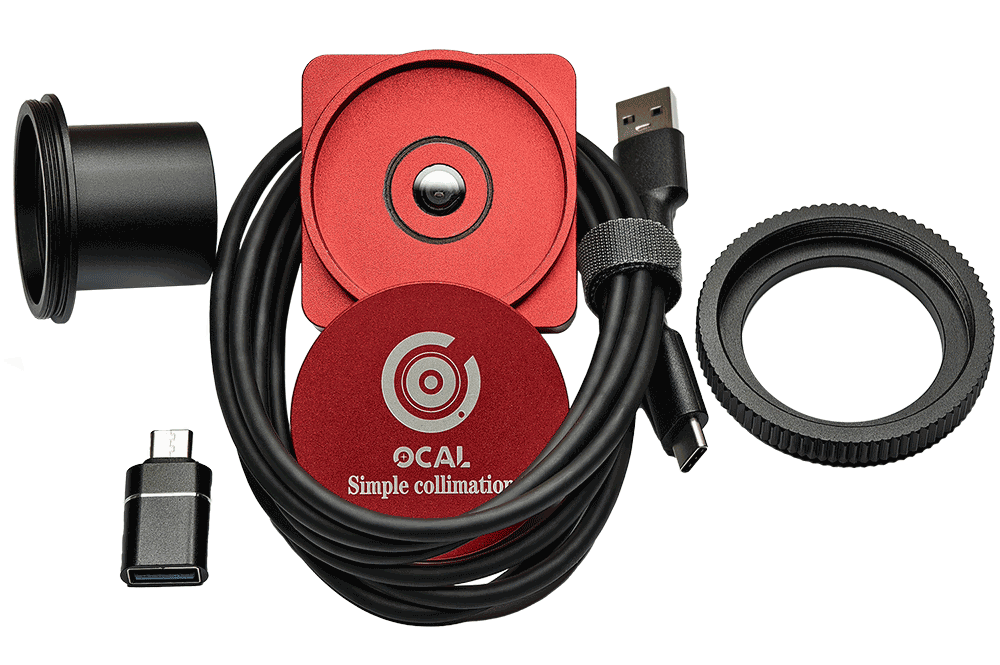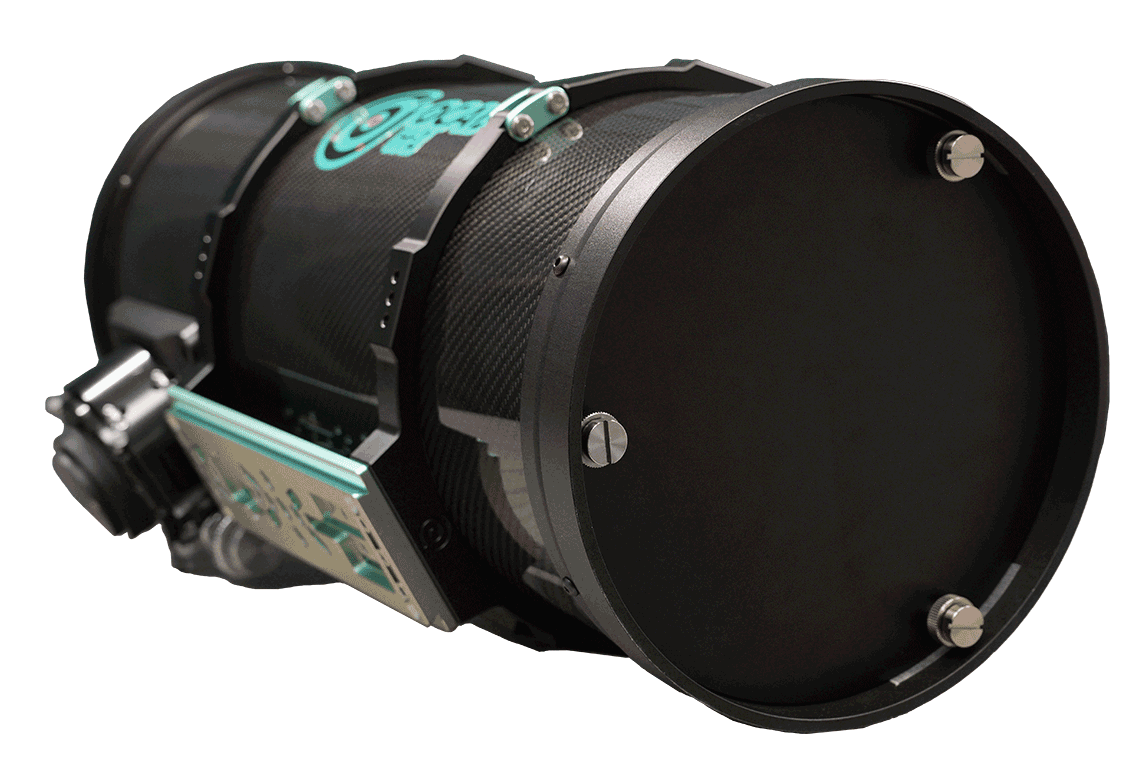
All products
OCAL 3.0 Electronic collimator
OCAL 4.0 Electronic collimator
OCAL H-2 Astrophotography Telescope





The collimation problem of the reflecting telescope is a problem that astronomers must solve.OCAL electronic collimator is an electronic device developed by Chaoxing Astronomy to calibrate the collimation of reflective telescopes. Its main function is to mark several calibration circles through software to achieve the purpose of collimation.





Since the release of the first generation OCAL electronic collimator, it has achieved great success and has been recognized by many astronomy enthusiasts around the world. Adhering to the concept of "keeping integrity and innovation", we continue to increase investment, conduct in-depth research and development, and are committed to producing telescope collimators with higher precision. After the efforts of the first, second and third generation collimators, we specially customized the 3.0 MAX version of the electronic collimator, which is the best among all current versions. It has significant improvements in the following two aspects.





The previous generation of OCALElectronic collimator 3.0MAX, relying on the 3A process of the module and high-precision assembly technology, achieved a leapfrog improvement in accuracy and stability. Once launched, it received widespread acclaim in the market due to its excellent performance.





OCAL H-2 is a Newtonian reflecting astronomical telescope developed specifically for astronomical photography. Its model is H-206, with a primary mirror aperture of 206mm and a focal ratio of F2.72. A focal length of about 560mm can cover the shooting of most celestial bodies and present the fine details of celestial bodies.





The collimation problem of the reflecting telescope is a problem that astronomers must solve.OCAL electronic collimator is an electronic device developed by Chaoxing Astronomy to calibrate the collimation of reflective telescopes. Its main function is to mark several calibration circles through software to achieve the purpose of collimation.





Since the release of the first generation OCAL electronic collimator, it has achieved great success and has been recognized by many astronomy enthusiasts around the world. Adhering to the concept of "keeping integrity and innovation", we continue to increase investment, conduct in-depth research and development, and are committed to producing telescope collimators with higher precision. After the efforts of the first, second and third generation collimators, we specially customized the 3.0 MAX version of the electronic collimator, which is the best among all current versions. It has significant improvements in the following two aspects.





The previous generation of OCALElectronic collimator 3.0MAX, relying on the 3A process of the module and high-precision assembly technology, achieved a leapfrog improvement in accuracy and stability. Once launched, it received widespread acclaim in the market due to its excellent performance.





OCAL H-2 is a Newtonian reflecting astronomical telescope developed specifically for astronomical photography. Its model is H-206, with a primary mirror aperture of 206mm and a focal ratio of F2.72. A focal length of about 560mm can cover the shooting of most celestial bodies and present the fine details of celestial bodies.


The collimation problem of the reflecting telescope is a problem that astronomers must solve.OCAL electronic collimator is an electronic device developed by Chaoxing Astronomy to calibrate the collimation of reflective telescopes. Its main function is to mark several calibration circles through software to achieve the purpose of collimation.
1、Each Collimator has perfect pixel level accuracy in our high quality control. 2、Installing the collimator by M42 threads minimizes the install error. 3、The collimation errors may cause by different visual axis of human eyes in the traditional collimation tools. It can be total eliminated by OCAL. 4、The product can solve the problem of collimating large telescopes, with the assistance of collimation result shows on screen immediately. 5、4 steps collimation by this product. It is easy and suitable for everyone. 6、You can share your collimation result by screenshot. Or sending your collimation screenshot to us to get technical support. 7、Compared with the 2.0 optical axis calibrator, the OCAL3.0 electronic optical axis calibrator has a greater breakthrough in hardware.
1、Brand new large aperture lens and CMOS, with the same ambient brightness, the exposure time of OCAL3.0 electronic collimator is only 1/20 of the second generation electronic collimator. Now the new calibrator can be used in darker environments Adjust the telescope to be collimated. 2、The clarity of the OCAL3.0 electronic collimator image has been greatly improved. Now you can see clearer primary mirror marks and more reflection information, and it still performs well when equipped with a correction mirror. https://www.youtube.com/watch?v=Hw9lqDrLTzM 3、In the future, we plan to release a high-end 3.0MAX version. We have completed the theoretical design work. The new version has been specially designed. In theory, it is possible to use manual adjustments to the chip tooling on the optical equipment. The MAX version will Mainly dealing with small focal ratio telescopes, this is our challenge for higher goals in the future.



Since the release of the first generation OCAL electronic collimator, it has achieved great success and has been recognized by many astronomy enthusiasts around the world. Adhering to the concept of "keeping integrity and innovation", we continue to increase investment, conduct in-depth research and development, and are committed to producing telescope collimators with higher precision. After the efforts of the first, second and third generation collimators, we specially customized the 3.0 MAX version of the electronic collimator, which is the best among all current versions. It has significant improvements in the following two aspects. 1、We believe that only by minimizing the error of the collimator itself can we bring better results to the telescope collimation. Therefore, we use the best camera module assembly method in the industry, which allows the lens, CMOS The tilt error has reached a high-quality level recognized in the industry. The average tilt deviation of the 3.0 MAX camera module is expected to be <10′, which greatly reduces the error demonstrated in Figures 2, 3, and 4.

2、We have also made major changes in the assembly of the camera module and metal casing. We changed the previous solution of only using screws to limit fixation to a solution of limiting slots and separating the camera module from the PCB. . This solution ensures the assembly accuracy of the camera module and the housing, and the uncertainty in the strength of the screws that fix the PCB will not affect the camera Assembly drawing

The 3.0 MAX collimator must use the latest software version. The software operation and tutorial content have not been changed and remain consistent with version 3.0. Finally, the R&D investment in the 3.0 MAX version has increased our production costs. We believe that for some telescopes with shorter focal lengths and larger focal ratios, the electronic collimator version 2.0 can already meet the needs of most customers. In order to provide a better purchasing experience for some customers who do not have high accuracy requirements, we have decided to stop sales 2.0 PC version, and the price of the 2.0 PRO version has been significantly reduced. Hope everyone knows, thank you!

Dear partners, it is my great honor today to present to you the new generation of OCAL Electronic collimator 4.0! The previous generation of OCALElectronic collimator 3.0MAX, relying on the 3A process of the module and high-precision assembly technology, achieved a leapfrog improvement in accuracy and stability. Once launched, it received widespread acclaim in the market due to its excellent performance. However, the 3.0MAX is not perfect. Its large module and heavy weight make it extremely prone to a decrease in accuracy if it is bumped or dropped during daily use. At the same time, the high cost also leads to a relatively high retail price, which limits the popularity of the product to a certain extent. To overcome these problems, the R&D team spent two years in research and development and officially launched the OCAL Electronic collimator 4.0. Compared with the 3.0MAX, the 4.0 version only has a slight reduction in the aperture, but it brings more advantages as follows:
Image Quality Innovation: Equipped with higher pixels and advanced CMOS technology, it has achieved a comprehensive surpassing of the 3.0MAX in terms of image quality and clarity. It can capture details more accurately, and the image presentation is more delicate and realistic.
Display Optimization:Adopting a 4:3 screen-to-body ratio design, compared with the 16:9 ratio, it can more efficiently display the internal structure of the other side of the telescope, providing users with more and more intuitive observation angles.
Stability Upgrade: Continuing the 3A process and high-precision assembly technology of the 3.0MAX, with a smaller volume and lighter weight, it further improves the product's stability. It is not afraid of slight collisions and shakes during daily use, and the calibration accuracy remains consistent.
Appearance Enhancement: The shell has been changed to red, and a carefully designed circle of markings on the shell enables users to more clearly identify the reflective surface of the calibrator, making the operation more convenient and efficient.
Cost-effectiveness Leap:While ensuring the core performance, the cost has been reduced, and it is offered to the market at a lower retail price. It truly achieves an upgrade in performance and an affordable price, bringing users a choice with higher cost-effectiveness.


OCAL H-2 is a Newtonian reflecting astronomical telescope developed specifically for astronomical photography. Its model is H-206, with a primary mirror aperture of 206mm and a focal ratio of F2.72. A focal length of about 560mm can cover the shooting of most celestial bodies and present the fine details of celestial bodies. To achieve excellent optical performance at a small focal ratio, it has been carefully designed in both optical and mechanical aspects. With an excellent optical system design, and strict detection by optical equipment such as interferometers and eccentric meters, the quality of the lenses is ensured to be top - notch. The mechanical positioning design of the main mirror, the precise fine - tuning design of the secondary mirror, the focusing base design, and the micro - heating dew removal design of the optical system comprehensively guarantee the shooting effect.
When you purchase the OCAL H - 2you will get a complete set of equipment: One set of telescope main body, including components such as a Telescope Tube clamp, dovetail plate, focuser, and correctors. One copy of a simple product introduction. OCAL anti - dew system. Several screwdrivers and hex wrenches for telescope adjustment. Several data cables and DC wires. One matching aluminum case with wheels.



Fused Silica Glass Substrate


Large-diameter correctors and dedicated 2.5-inch focusing base support full-frame shooting


Dehumidification device prevents condensation on the lens by real-time detection of temperature and humidity


Secondary mirror precision adjustment structure


Primary mirror Position Fixing and Primary mirror Adjustment Screws


Markings on the Primary Mirror and Secondary Mirror




Professional Production and Detection Equipment

Parameters: Camera 2600MC, single exposure 300S, Environment: Class 4 light pollution